Lobster mushrooms are a real treat of a wild mushroom. They’re dense and meaty and taste great. Although they don’t taste a lot like ocean lobsters, they do often have a seafoody smell. Some people say that the mushrooms taste slightly of seafood, but in general, they’re mild and slightly sweet. Their name comes from the uber-brilliant cooked-lobster shell coloring and the strong seafood scent that develops when they’re past maturity.
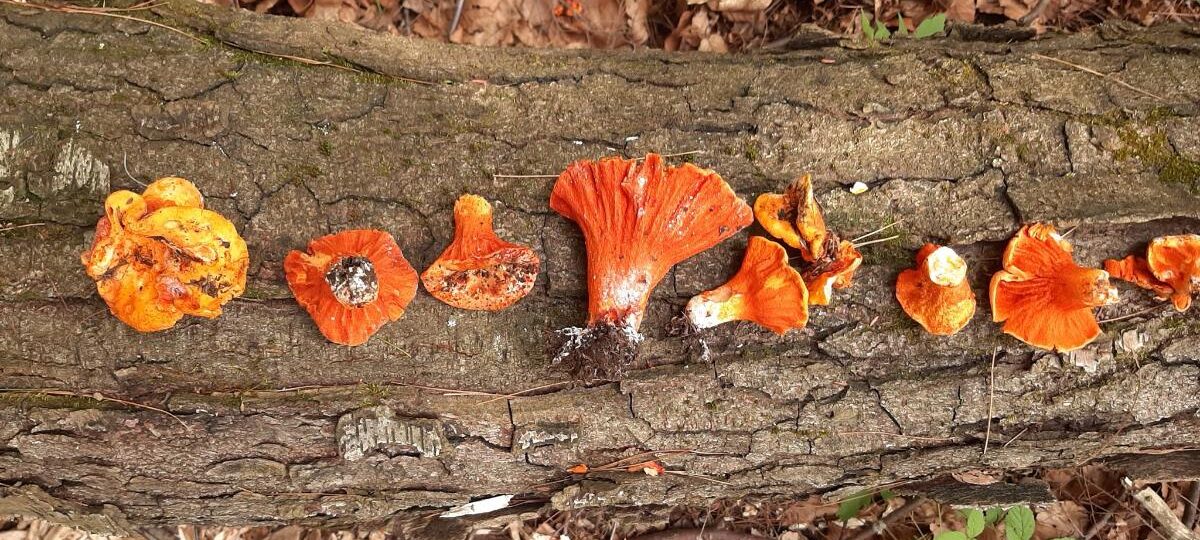
Lobster mushrooms can’t be grown, so to enjoy this wild edible species, you’ll need to forage them, make friends with some foragers, or be lucky enough to find them at a local grocer or farmer’s market. They’re worth the effort, though!
These mushrooms stay fresh up to seven days after harvesting, but they taste best when used within three days. Keep this in mind when you get them; the quicker you prepare them, the better. Lobster mushrooms are excellent cooked in many ways. You can sauté them, deep-fry them, or add them to pizza or stews.
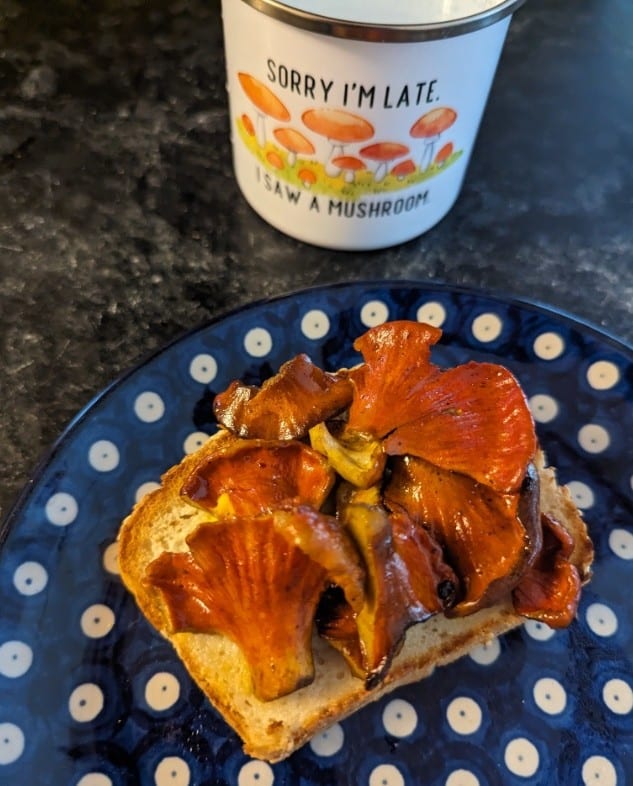
Jump to:
What Are Lobster Mushrooms
These aren’t your typical mushrooms. They are the result of the parasitic fungus Hypomyces lactifluorum attacking other mushrooms and turning into a completely different form.
The parasitic process begins underground when Hypomyces lactifluorum infects specific mushroom species. It primarily targets members of the Russulaceae family. And, most commonly, it attacks Russula brevipes (Short-Stemmed Russula) and certain species of Lactarius. As the infection progresses, the parasite gradually conquers the host mushroom. The transformation starts at the edges of the cap, moves to the rest of the cap, and finally to the stem.
Throughout this transformation, the parasite completely alters the host’s DNA structure. Research from Quebec revealed that infected mushrooms contain predominantly lobster mushroom DNA, with merely trace amounts remaining from the original species. Additionally, the parasitic process modifies the metabolites – compounds that determine the mushroom’s appearance, taste, and edibility.
One remarkable aspect of this parasitic relationship is that the parasitization completely changes the culinary value of the mushroom. For example, Lactarius piperatus is a very peppery mushroom that is basically inedible because of its spiciness. However, when Hypomyces lactifluorum infects it, the parasite neutralizes the heat and creates a more palatable and downright tasty mushroom.
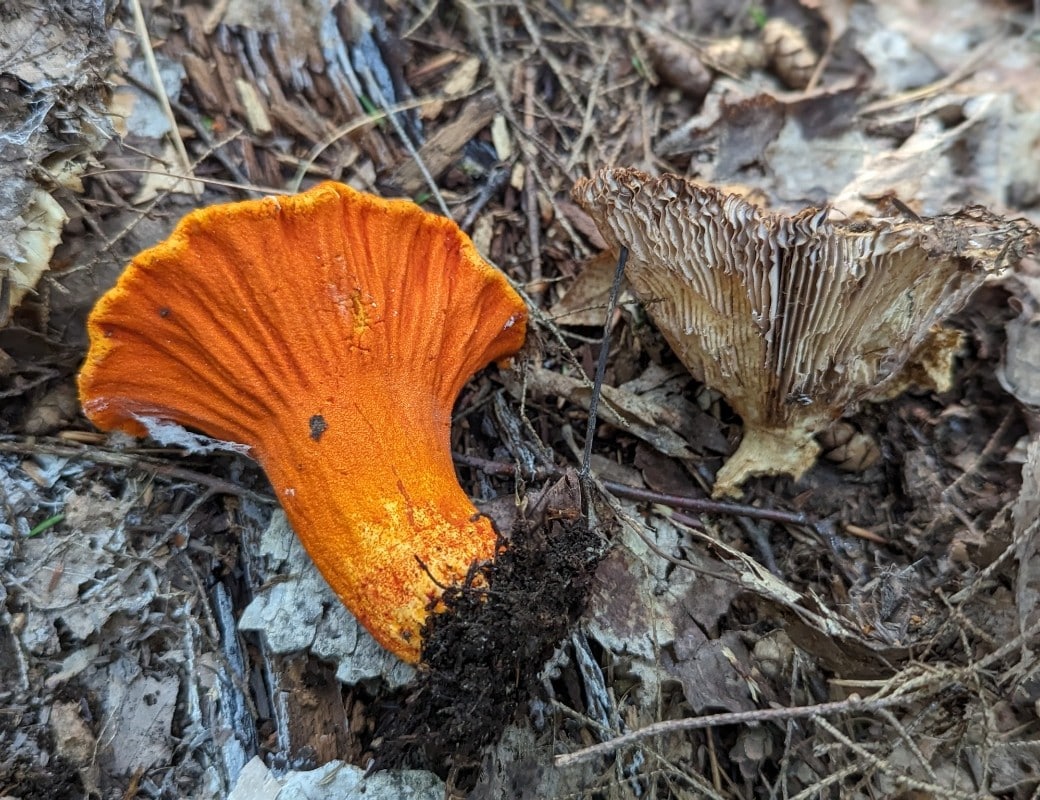
Lobster Mushroom Identification
The most noticeable characteristic of the lobster mushroom is the bright orange to orange-red crust that completely covers the mushroom’s surface. This hard, exterior layer develops tiny pimples or bumps, which, combined with the color, make it look for all the world like a cooked lobster shell.
These are stout, dense mushrooms with no gills and a thick stem. The caps are often misshapen, lumpy, or wrinkled. Underneath the cap, the surface is smooth or slightly ridged. The interior flesh is pure white and firm and dense. When the flesh is cut, it doesn’t stain or bruise.
As these mushrooms age, their appearance changes. The bright orange color deepens to a darker red, and it often turns purplish. The mature mushrooms also form white powdery spores under the cap. Older lobster mushrooms develop a distinct marine or fishy aroma, which can be quite strong. This is a sign the mushrooms are past prime for eating, and those super fishy-smelling ones should be left in the woods.
The size of lobster mushrooms can vary considerably. Some specimens are small enough to fit in your palm, while others are as large as a head of broccoli. Often, these mushrooms begin growing beneath the soil surface. They create characteristic bulges known as ‘shrumps’ among mushroom hunters.
The transformation process is very thorough – once fully parasitized, the original host becomes completely unrecognizable. This comprehensive makeover, coupled with their distinctive appearance, makes lobster mushrooms relatively straightforward to identify, particularly for beginning foragers.
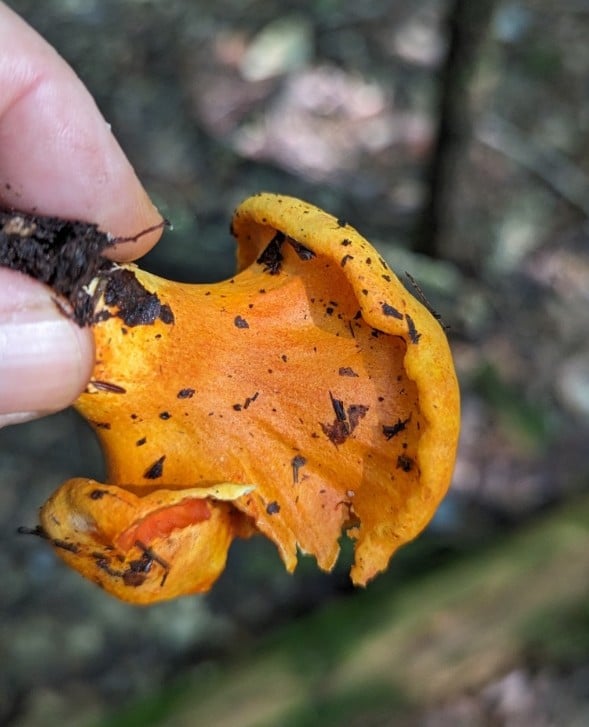
Foraging Lobster Mushrooms
Lobster mushrooms are mid-summer to fall mushrooms that grow on the ground. Because of this, they are often covered in leaf litter, pine needles, and dirt. When you’re out in the field, try to remove as much of this as possible before adding the mushrooms to your bag or basket.
To learn more about foraging wild lobster mushrooms, check out our guide: Lobster Mushrooms: Foraging, Harvesting, and Cooking Guide.
Brush off loose debris and cut the stem at the base since it is usually caked with dirt. If you do this in the field, you’ll reduce the amount of cleaning you need to do later on.

Lobster mushrooms can be big and dense, but they can also be small and brittle. It’s best to store the smaller ones by themselves where they won’t get too jostled or crowded. They will break into a hundred pieces very easily. Larger mushrooms are hardier and can be stored with other mushroom finds, but it’s still best to treat them as gently as possible.
It’s good to gather lobster mushrooms in a wide basket where the weight can be spread out and they aren’t piled too high on top of each other. A bag is also fine, but they can easily be crushed if there are a lot of them.
Selecting Quality Lobster Mushrooms
The first quality indicator comes from the exterior color. Look for specimens with a bright orange to reddish-orange hue. Stay away from mushrooms that have purple or dark brown discolorations – these signs mean they’re aging and might make you ill. There are often white patches on the caps, and this is normal. These are remnants of the original mushroom and are a sign that the specimen isn’t fully parasitized. They’re still edible like this, though, without issue.
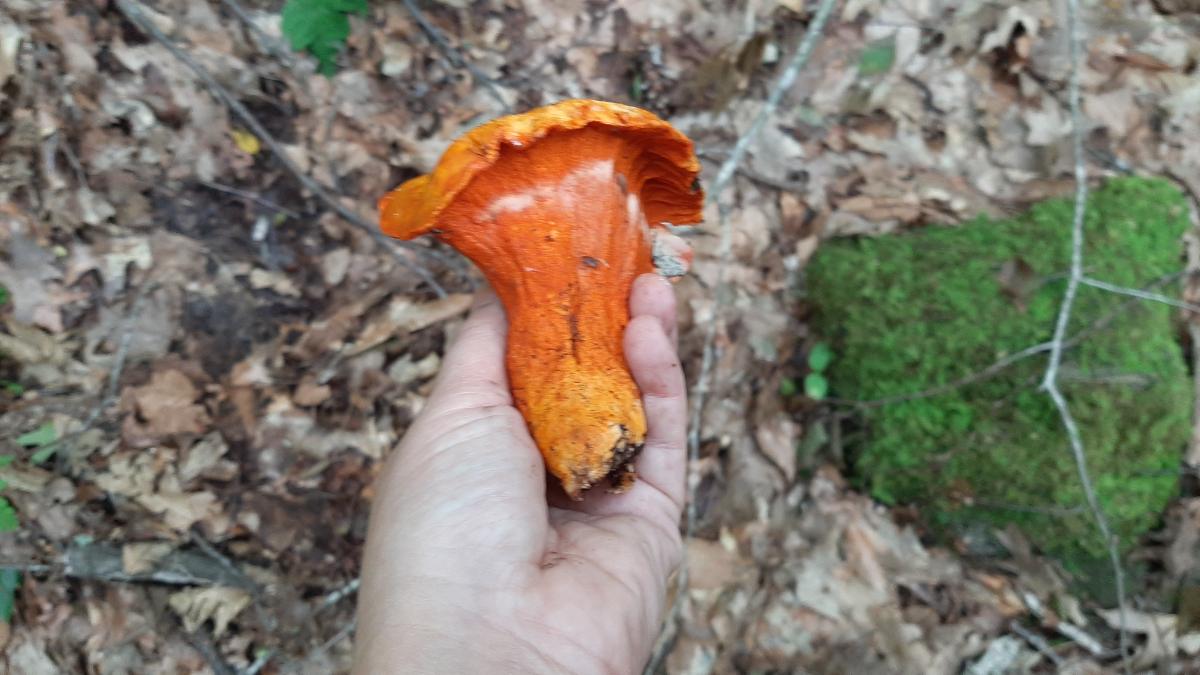
The interior flesh should be pristine white. If there is any discoloring, the mushroom is starting to decompose and is not good to eat. The mushroom should be dense and firm to the touch when you press it gently. It should have a density similar to a paperweight. If it is at all soft or mushy, again, this is a sign it has started decomposing and should not be eaten.
The mushroom should feel dense and heavy in your hand, not light or hollow. Look for a consistent texture throughout, without any soft or spongy spots.
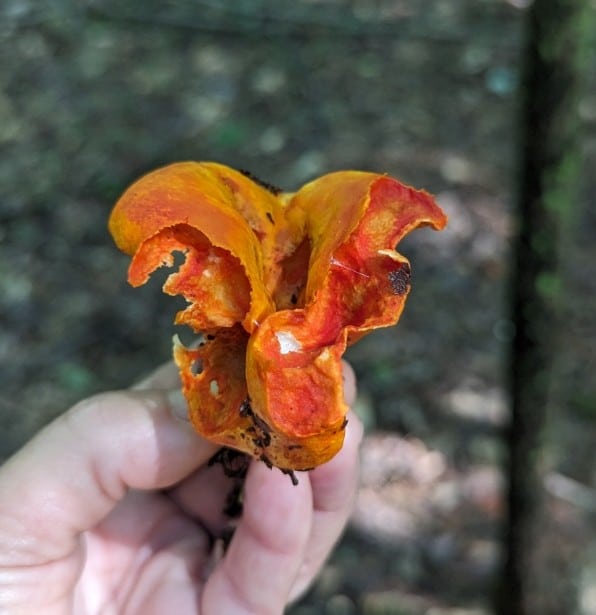
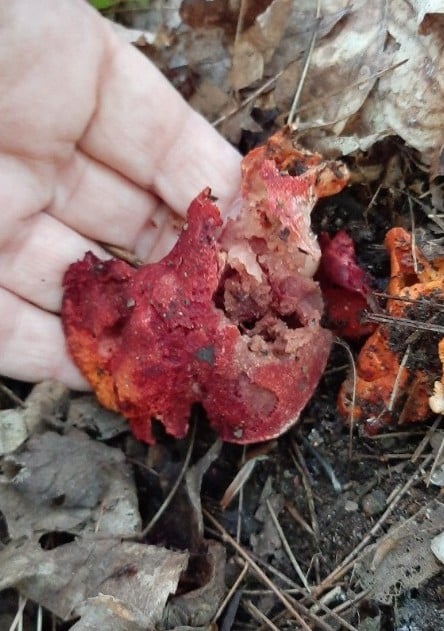
Fresh specimens have a subtle, pleasant, earthy aroma with very slight hints of seafood. Aging mushrooms develop an unmistakable fishy odor – that’s your signal to avoid them.
What To Look For:
- A firm, dense structure
- Minimal blemishes or dark spots
- Clean, white flesh (cut the mushroom in half to check!)
- No purple or wine-colored staining
- No soft or mushy flesh
- Mild smell. A pungent fishy smell means they’re too far gone.
- Minimal to no bug tunnels or extensive larval damage
Do a cross-section to check for gnat larvae tunnels — these speed up deterioration, destroy the texture, and alter the overall flavor. Eating larvae won’t harm you, but their presence means quality problems. There’s another reason to check – compacted dirt in folds and crevices. While you can clean it, too much debris hints at poor storage.
The best results come from specimens at peak freshness. Quality lobster mushrooms stay fresh for 3-4 days in proper refrigeration. Pick mushrooms that show clear freshness signs and use them soon after purchase.
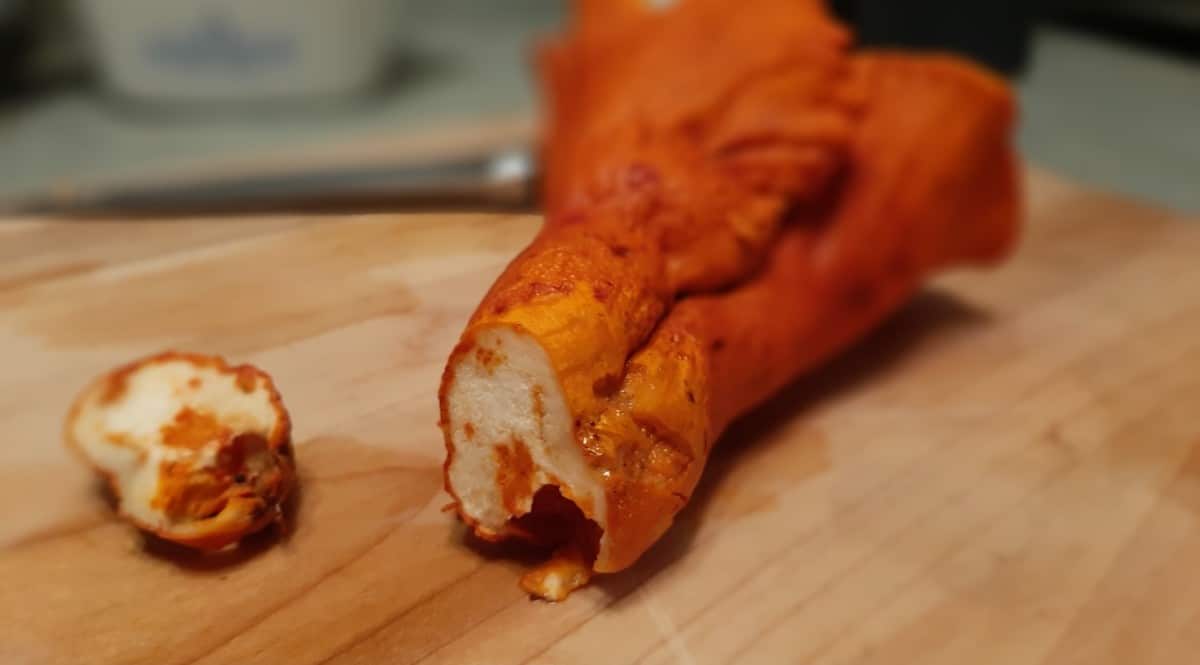
How To Store Lobster Mushrooms
Do not wash your mushrooms before storing them. Getting them wet and then putting them in the refrigerator will speed up their decomposition process, and they won’t last as long.
Raw lobster mushrooms are best stored, uncleaned, in paper bags inside your refrigerator’s low-humidity drawer. Just roll the bag’s top to close it. This creates a protective space where the mushrooms can breathe. The fresh specimens will stay good for three to seven days this way.
Do not wrap or store the mushrooms in plastic. This also speeds up the decay process by trapping moisture. It will turn the mushrooms slimy.
Look at each mushroom carefully before you refrigerate it. One bad one can spread its decomposition to others. Take out any that show these signs:
- Slimy or damp surfaces
- Moldy patches
- Discoloration (white is okay, but not purple or wine-colored)
- Withered appearance
Freezing
Lobster mushrooms freeze quite well, but only after being cooked. Raw freezing isn’t the best idea since ice crystals damage the mushroom’s structure. The thawed mushroom is mushy and weird.
You can prepare the lobster mushrooms in a recipe, like a stew or casserole, and freeze the entire dish. Another option is to boil the mushrooms for 10-15 minutes before freezing. Drain and cool them, and then freeze for later use.
Drying
Dehydrating lobster mushrooms is a quick and easy way to keep the mushrooms for a longer time. Dried mushrooms can last a year or more. This method is great for lobster mushrooms because it concentrates their flavors.
Here’s how to get the best results:
- Slice mushrooms thinly so they dry evenly
- Put pieces on drying racks or screens
- Don’t stop until they’re cracker-dry
You don’t need a dehydrator to dry lobster mushrooms. There are quite a few ways to dry mushrooms. One option is to air-dry them. String sliced mushrooms together and hang them somewhere dry. Or, put the mushrooms in your oven on the warm setting with the door cracked open. They’ll dry in 4-8 hours this way. Whatever method you pick, make sure the mushrooms are brittle when they’re done. If they have any moisture in them, they might mold during storage.
Keep the dried lobster mushrooms in sealed containers away from sunlight. When you’re ready to use them, soak them in room temperature water for 15-30 minutes.
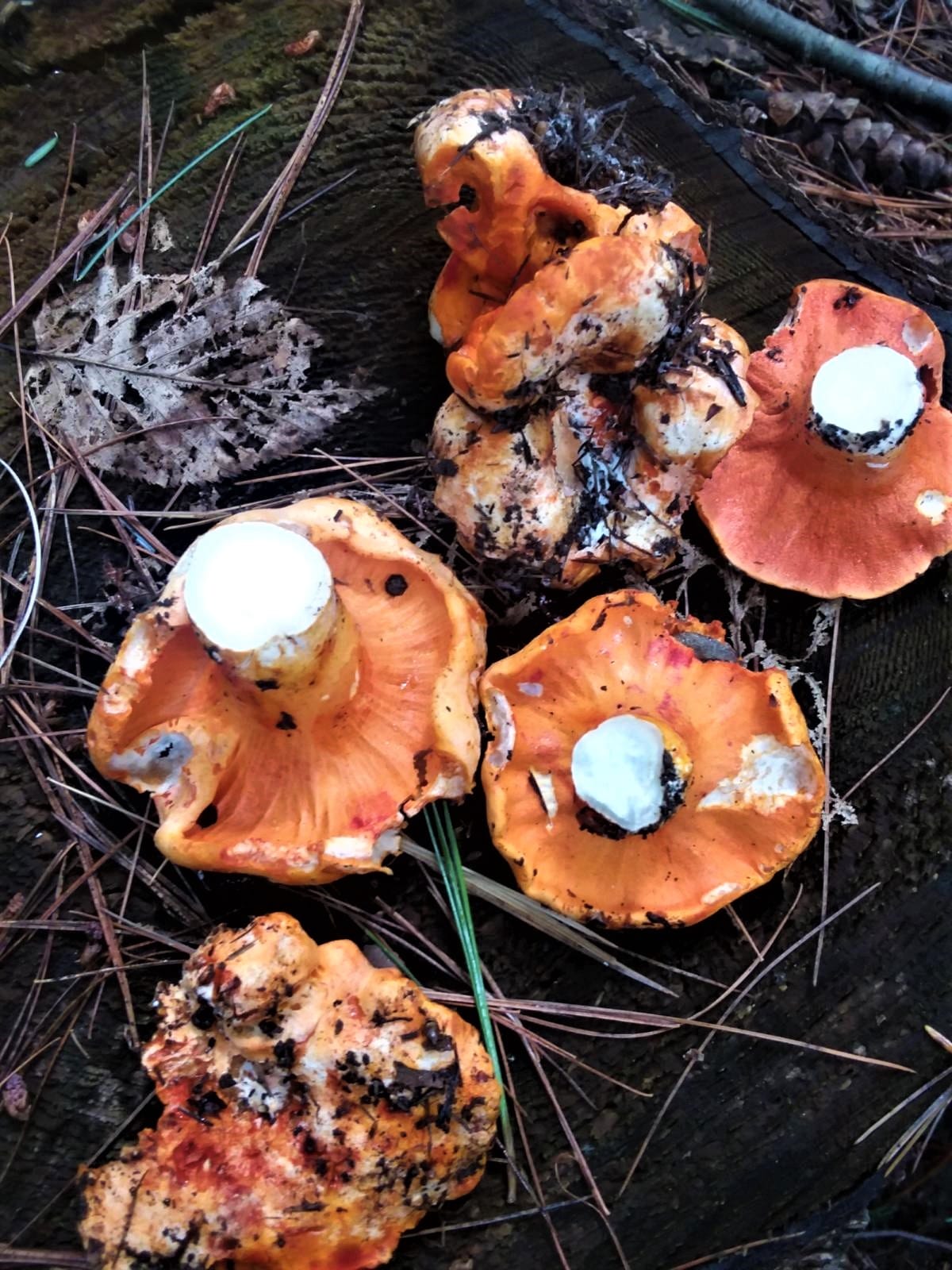
How To Clean Lobster Mushrooms
Cleaning lobster mushrooms is absolutely essential before cooking them. Unfortunately, these mushrooms can be tricky to clean because of all the folds, ridges, and deep centers that trap soil, leaf litter, and debris. Bring some patience with you before you start cleaning lobster mushrooms! Not only are they often super dirty, but smaller ones can be very brittle, so you have to handle them carefully or they’ll break apart.
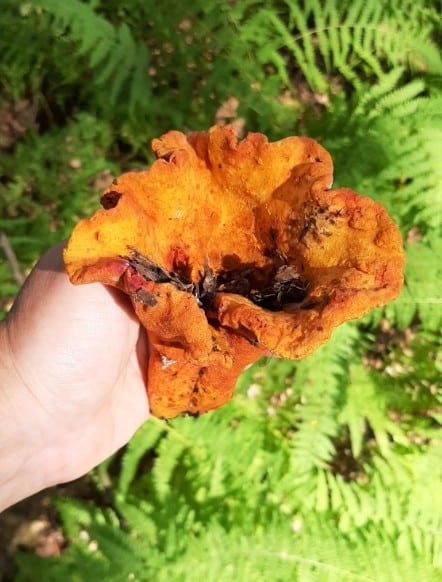
Start off by dry cleaning the mushrooms. Use a soft-bristled brush like a pastry brush or clean toothbrush to remove as much surface debris as possible. Next, gently scrub the exterior surface and be sure to check the entire cap surface and its crevices. There are often hidden pockets between folds of the cap.
It helps a lot to break the larger mushrooms apart to reach the more difficult areas. Debris loves to hide in the folds. Use a paring knife to trim away any brown spots or damaged areas you find while cleaning. The paring knife also works well to cut away and super dirty/debris-filled areas.
Just be gentle while cutting away parts of the mushroom. Even though the flesh is dense, it is also brittle, and the mushrooms split in half or more quite easily. Lobster mushrooms are tougher than other mushroom types, but too much scrubbing or aggressive cleaning can damage them.
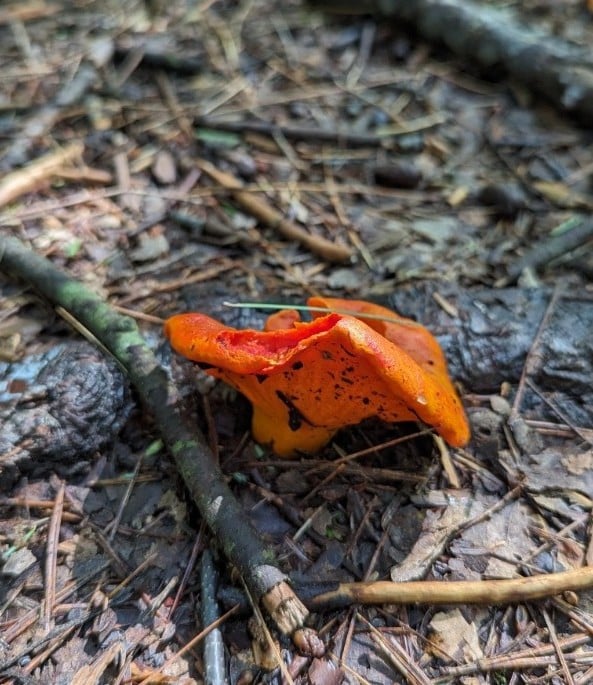
Many think you shouldn’t wash wild mushrooms, but lobster mushrooms are tough enough to handle careful washing. Like with the other cleaning, be gentle so the mushrooms don’t snap apart.
- Place the mushrooms in a strainer.
- Rinse briefly under cold running water.
- Use your hands or a soft brush to rub or gently scrub away trouble spots
- Pat gently with paper towels to remove remaining moisture
- Let air dry thoroughly before cooking
Don’t soak these mushrooms in standing water unless you plan on using them immediately. Once they’re soaked, their lifespan is extremely short. A lot of people don’t like to soak mushrooms because it causes them to get waterlogged or mushy, but this isn’t always a problem. It all depends on what you intend to do with them.
If you’re planning on cooking them right away, waterlogged mushrooms might not be good for your dish. But you can dry sauté them first or as a preparation method. Dry sautéing is an excellent way to cook soaked wild mushrooms.
Alternatively, if you don’t want soggy mushrooms, plan on letting them air-dry completely before cooking with them. Put them on clean kitchen towels or paper towels where air can circulate to prevent moisture buildup. This drying step will keep their firm texture.
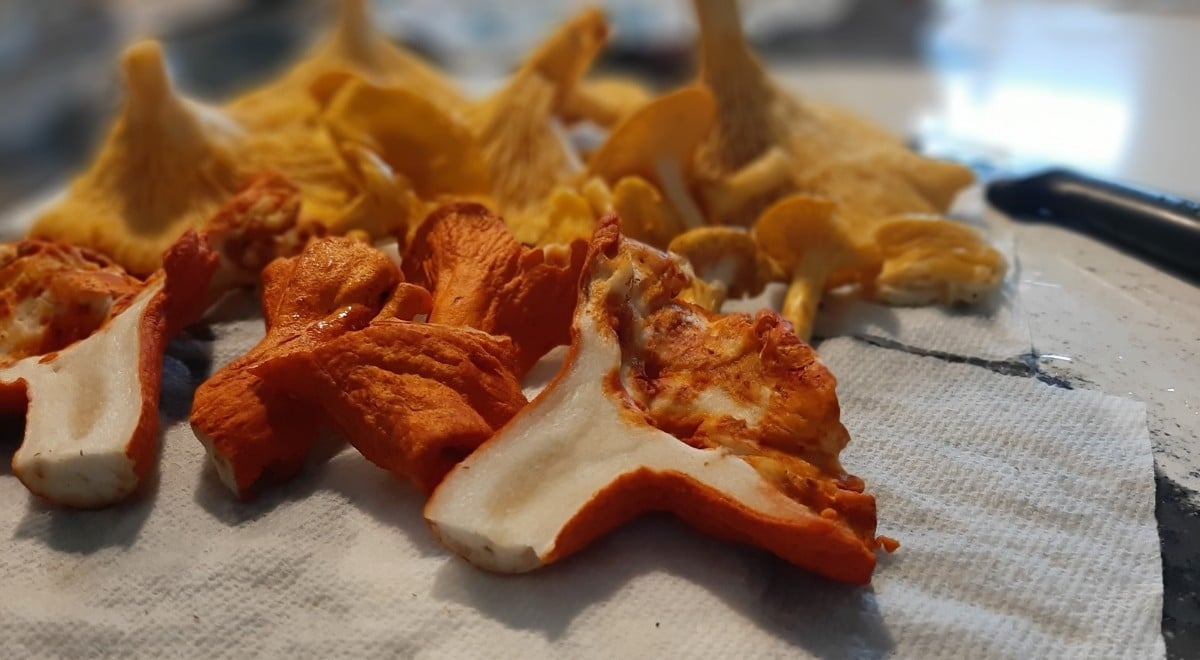
How To Cook Lobster Mushrooms
Lobster mushrooms are excellent cooked simply or prepared more elaborately. They’re pretty versatile. The mushrooms keep their density and shape through cooking, which is a nice aspect. They won’t cook down or reduce much during cooking. Their texture is actually quite similar to seafood, dense with a little bit of chew.
Lobster mushrooms have a mild taste that works wonderfully with simple spices. Here are some great flavor combinations that work well:
- Butter and fresh herbs like thyme and parsley
- Garlic and chili with smoked paprika
- Shallots mixed with white wine or marsala
Many people like to substitute lobster mushrooms in dishes that call for ocean lobsters for a meat-free alternative. The brilliant red of the lobster mushroom exterior and its white flesh make it look like a lobster of the sea. But the taste is not the same.
Lobster mushrooms do not (and should not!) taste strongly of seafood. If they smell or taste very strongly fishy, they are too far gone for eating. They will have a light seafood reminiscent to earthy scent, and that’s great, and it does transfer well to lobster dishes. However, don’t expect them to be a one-for-one exchange in a recipe.
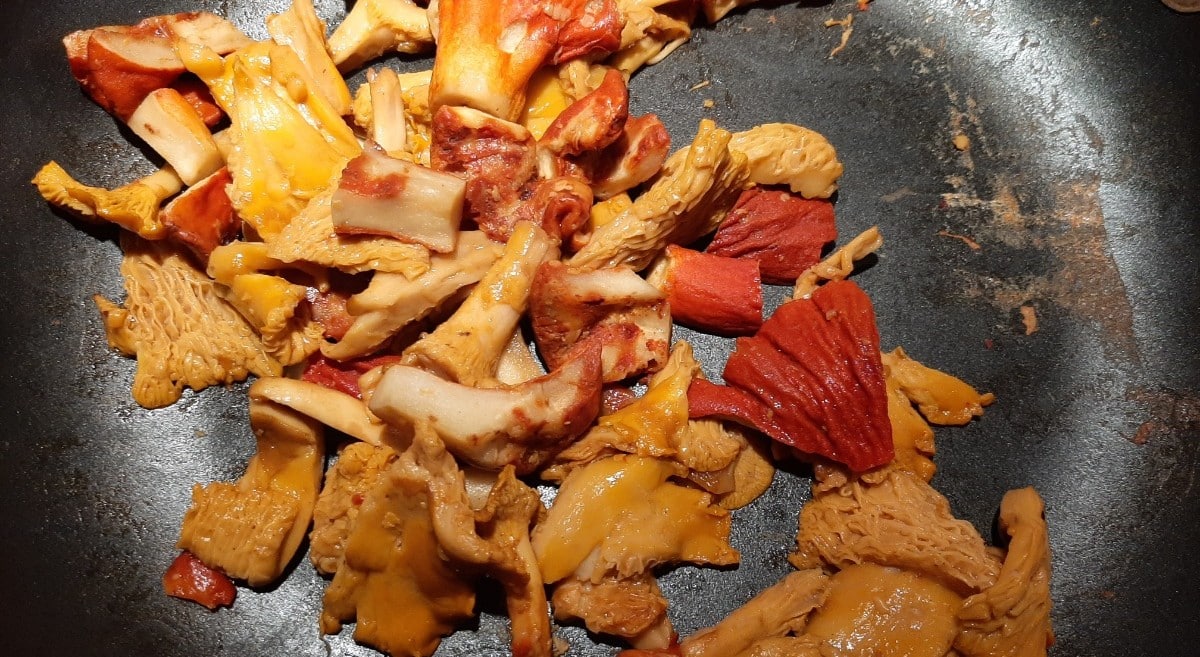
Pan searing
Pan searing is a fantastic and simple way to prepare lobster mushrooms. This is the best way to really taste their natural flavor. We always recommend pan-frying mushrooms that are new to you to get a feel for their taste and texture.
Start with a preheated pan over medium-high heat. Add a pat of butter or olive oil when the pan is hot. Slice the mushrooms uniformly and spread them in the pan with space between them. Cook them 2-4 minutes on each side to develop a golden-brown exterior. As they cook, the mushrooms will release their natural juices and turn everything orange. You can add minced garlic, thyme, parsley, or other spices towards the end of cooking. Serve as a side dish or snack.
Roasting
Roasting is another excellent way to prepare lobster mushrooms. This will give them a crispy exterior while staying meaty inside. To begin, set your oven to 375°F. Lay the mushrooms out in a single layer on a lightly oiled baking pan. Let them roast for ten minutes, then flip over and cook for another 5 minutes or until your desired crispiness.
Feel free to add seasonings like garlic, herbs, or salt and pepper before roasting or after.
Lobster Mushroom Seasoning
You can make a unique seasoning rub with dried lobster mushrooms. Just grind the dehydrated mushrooms into powder and mix them with mild paprika and a touch of cayenne. This blend is an excellent seasoning for vegetables and main dishes. The seafoody flavor is more pronounced in the dried mushrooms, and that adds a nice depth to the seasoning mix.
Our Favorite Lobster Mushroom Recipes
- Lobster Mushroom Rolls
- Lobster Mushroom Rolls (different version)
- Lobster Mushroom Tempura
- Lobster Mushroom Patties
- Cantonese Ginger and Scallion Lobster Mushroom
- Lobster Mushroom Bisque
- Lobster Mushroom Obe Ata Stew
- Lobster Mushroom Chowder
- Lobster Mushroom Cakes
- Tofu with Lobster Mushrooms in Ginger Broth

Common Questions About Cooking Lobster Mushrooms
How do I clean lobster mushrooms?
The best way to clean lobster mushrooms is with a soft brush to remove surface dirt. Then, use a paring knife to cut off more embedded dirt and debris. Last, rinse the mushrooms briefly under cold water. Avoid soaking them, as this can affect their texture and flavor.
What’s the best way to cook lobster mushrooms?
It’s best to keep it simple. Pan-searing or sautéing in butter is a great way to cook lobster mushrooms. Their dense texture also works well with roasting. We recommend seasoning them just lightly so their natural flavor is highlighted.
How long do fresh lobster mushrooms last?
When stored properly in paper bags in the refrigerator, fresh lobster mushrooms can last 3-7 days. Do not wash them before storing them, as that will speed up the decomposition process.
Do lobster mushrooms really taste like lobster?
Opinions vary on whether lobster mushrooms really taste like seafood lobster. Many find that lobster mushrooms have a subtle seafood-like flavor and aroma, especially when fresh.
But it isn’t super strong when they’re young and fresh. As they age, the flavor and smell intensify, but the mushrooms aren’t good to eat at this point. The texture of lobster mushrooms is quite a bit like seafood as well.

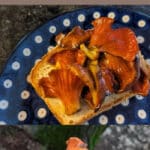
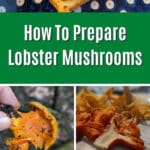
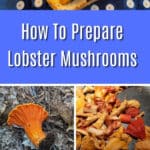
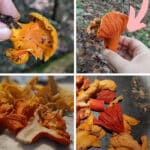

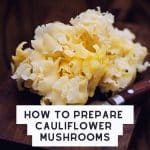
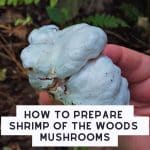
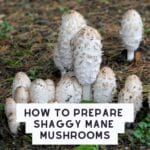
Leave a Reply